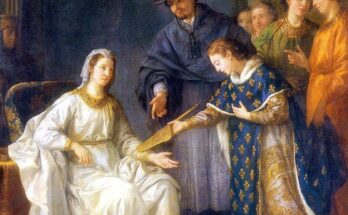Kungkarangkalpa by Tjanpi Women at the Potter Museum of Art
The arts of Australia’s First Nations peoples are a vibrant, living tradition that stretches back at least 65,000 years, representing one of the oldest continuous cultures on Earth. This deep history is eloquently showcased in 65,000 Years: A Short History of Australian Art, a landmark exhibition at the Potter Museum of Art. The exhibition, curated by the distinguished Professor Marcia Langton OM and Judith Ryan, gathers iconic works from communities across the continent, tracing the evolution of Indigenous Australian art and its enduring cultural significance.
Among these remarkable works stands Kungkarangkalpa (Seven Sisters), a striking creation by a group of Tjanpi women artists, made during the difficult COVID years. Loaned from the National Museum of Australia’s collection, this artwork shines brightly in the exhibition, carrying profound cultural narratives, artistic innovation, and a testament to resilience and community strength.
This essay delves into the essence of Kungkarangkalpa, the artists who brought it to life, its cultural and mythological roots, and its critical role within the wider context of Australian art history as showcased at the Potter Museum. Through this exploration, we honor the legacy, creativity, and enduring spirit of the Anangu and Yarnangu women whose work continues to inspire and educate.

The 65,000 Years Exhibition: A Journey Through Time and Culture
65,000 Years: A Short History of Australian Art is an ambitious and groundbreaking exhibition that highlights the vast expanse of Indigenous Australian artistic expression. Curated by Professor Marcia Langton OM, a renowned anthropologist and advocate for Indigenous rights, alongside art historian Judith Ryan, the exhibition presents a sweeping narrative — from ancient rock art and ceremonial objects to contemporary paintings and installations.
By integrating ancient artifacts with contemporary art, the exhibition underscores the dynamic continuity of Indigenous culture. It challenges reductive views that confine Aboriginal and Torres Strait Islander art to the past, emphasizing instead its ongoing evolution and vibrancy.
Within this rich tapestry of creativity, Kungkarangkalpa is not only a visual marvel but a cultural beacon that represents specific stories and identities of the Anangu and Yarnangu peoples of Central Australia.
Kungkarangkalpa (Seven Sisters): The Myth and the Art
The story of Kungkarangkalpa, or the Seven Sisters, is a central myth in the Aboriginal Dreaming — a complex and sacred worldview that guides law, culture, and spirituality. The Seven Sisters story, known by various names across different Indigenous groups, recounts the journey of seven ancestral women who flee a pursuer across the land and sky. This narrative is deeply woven into the landscape and cosmology, reflected in stars, rock formations, waterholes, and sacred sites.
The myth connects communities to their country, history, and identity. Each telling may vary slightly but carries common themes of survival, protection, kinship, and the interrelationship between people and the land.
The Tjanpi artists’ work visualizes this rich oral tradition in a tangible form, weaving together storytelling, culture, and artistic expression. The name Kungkarangkalpa itself resonates with the power and sacredness of the Seven Sisters narrative.

Tjanpi Artists: Creativity, Community, and Resilience
The Kungkarangkalpa piece was created by a collective of Tjanpi women artists, including Dianne Golding, Dorcas Bennett, Nancy Jackson, Nangawarra Ward, Cynthia Burke, Winnifred Reid, Roma Butler, Martha Ward, Polly Jackson, Erica Shorty, Chriselda Farmer, Delilah Shepherd, and others, some of whom have since passed on.
Tjanpi Desert Weavers, established in 1995, is a women’s collective that works primarily with desert grasses (tjanpi) to create sculptural art. The collective empowers women from remote communities in Central Australia by nurturing traditional knowledge and providing avenues for economic and creative expression.
During the COVID years, when many social and cultural gatherings were restricted, the Tjanpi women continued their practice, using art as a source of connection, healing, and cultural transmission. Their collaborative approach exemplifies the strength of community and the persistence of tradition under challenging circumstances.
Each artist brings her own knowledge, style, and stories to the work. Their weaving techniques — hand-spinning, coiling, and binding the desert grasses — transform natural materials into dynamic forms, rich with meaning and vitality.
The Artistic and Cultural Significance of the Work
Kungkarangkalpa (Seven Sisters) is more than a physical object; it is a living narrative, a cultural artifact, and a symbol of survival and identity. Its presence in the Potter Museum’s exhibition elevates it beyond regional recognition, inviting national and international audiences to engage with Indigenous stories from Central Australia.
Visually, the work shines with the natural textures and warm colors of desert grasses. Its intricate construction reflects the patient skill of the artists, while its form evokes the dynamism of the mythic journey of the sisters. The physicality of the piece invites viewers to consider the deep connections between land, culture, and people — connections that are inseparable in Aboriginal worldviews.
Moreover, the piece stands as an emblem of women’s strength. The Seven Sisters narrative centers on the agency, resilience, and solidarity of women, a theme mirrored in the collective creation of the artwork itself. The artists’ ability to translate spiritual stories into physical forms that command respect in the art world underscores the power of Indigenous women’s leadership.
The Artists Behind Kungkarangkalpa: Stories and Legacy
The artists behind Kungkarangkalpa have rich personal histories and deep ties to their communities. Each woman contributes unique cultural knowledge and artistic vision.
- Dianne Golding is known for her storytelling through weaving and a commitment to passing on cultural knowledge to younger generations.
- Dorcas Bennett’s work often focuses on ancestral stories and connections to country.
- Nancy Jackson has been instrumental in advocating for women’s cultural rights and creative expression.
- Nangawarra Ward and Winnifred Reid brought their knowledge of local plant materials and traditional techniques to the collective.
- Roma Butler, Martha Ward, and Polly Jackson each have their own distinctive styles, contributing to the rich diversity of the Tjanpi collective.
- Erica Shorty, Chriselda Farmer, and Delilah Shepherd have continued to innovate within the collective, blending ancient stories with contemporary forms.
Sadly, some of these artists have passed away, but their legacy lives on through their work and the ongoing practice of Tjanpi Desert Weavers.
The Role of the National Museum of Australia
The Kungkarangkalpa work is loaned from the National Museum of Australia, an institution dedicated to preserving and sharing the stories of the nation, including those of its First Peoples. The museum’s support for Indigenous artists and its commitment to collaborative curation has been vital in bringing works like this to wider audiences.
By loaning Kungkarangkalpa to the Potter Museum of Art for 65,000 Years, the National Museum extends the reach of these stories and emphasizes their importance within the broader narrative of Australian history and culture.
Impact and Reception of the Work
The display of Kungkarangkalpa at the Potter Museum has received widespread acclaim. Audiences are captivated by the physical beauty of the piece and moved by the cultural depth it represents.
Critics have noted how the work challenges dominant narratives about Indigenous art, showing that Aboriginal art is not a static relic but a dynamic, evolving practice. The piece also serves as a vital educational tool, fostering understanding and respect for First Nations’ stories and traditions.
The artwork’s prominence in the exhibition inspires other Indigenous artists, particularly women, to continue creating and sharing their cultural heritage through art.
Conclusion: The Enduring Power of Story and Art
Kungkarangkalpa (Seven Sisters) is a beacon of culture, creativity, and resilience. Created by a group of extraordinary women during challenging times, it embodies the strength of community, the power of storytelling, and the continuity of Indigenous Australian culture.
Its presence in the 65,000 Years: A Short History of Australian Art exhibition is a testament to the rich and complex history of Aboriginal and Torres Strait Islander art. It invites all who see it to reflect on the enduring relationships between land, story, and identity.
In honoring the artists and their work, we also honor the deep cultural legacy of the Anangu and Yarnangu peoples and recognize the vital contributions of Indigenous women to the artistic heritage of Australia.
Kungkarangkalpa shines brightly, like the Seven Sisters themselves — a symbol of hope, survival, and the timeless power of art to connect us all.


